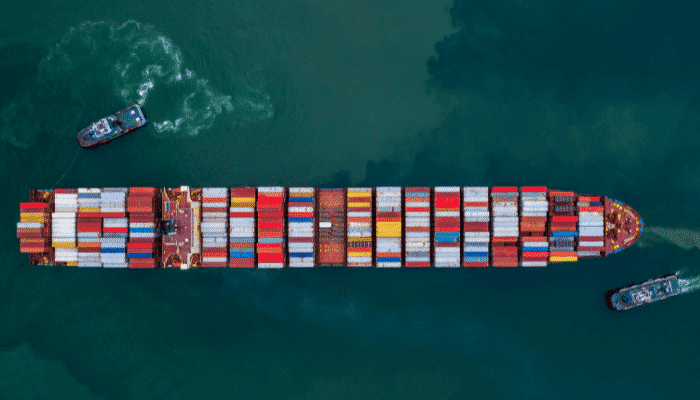
Schedule reliability drops to 56.7% in December
SCHINDELLEGI : As a leader in sea logistics, Kuehne+Nagel closely tracks and collects data on the movement of vessels, including actual arrivals and vessel delays. Kuehne+Nagel is publishing a summary of this analysis in monthly Schedule Reliability reports based entirely on neutral data.
December data shows that schedule reliability dropped once again, although not as severely as in the previous month. The decline was also reflected in the performance of individual carriers and on trade routes.
According to seaexplorer data, last month’s global on-time performance is in line with the December 2022 performance.
The graph below reveals that schedule reliability reached 56.7%, dropping four percentage points from November. This is the second-lowest level for 2023.
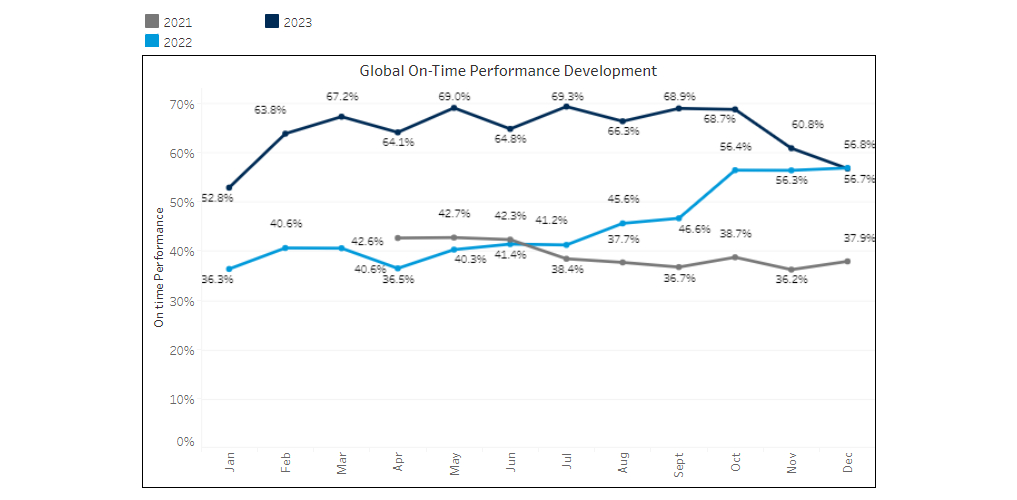
The average arrival delay of LATE vessels climbed slightly in December. Compared with November, the monthly average increased by only 0.2 days to 3.9 days.
Although below the 4-day mark, December 2023 performance is just 0.4 days away from December 2022 levels.
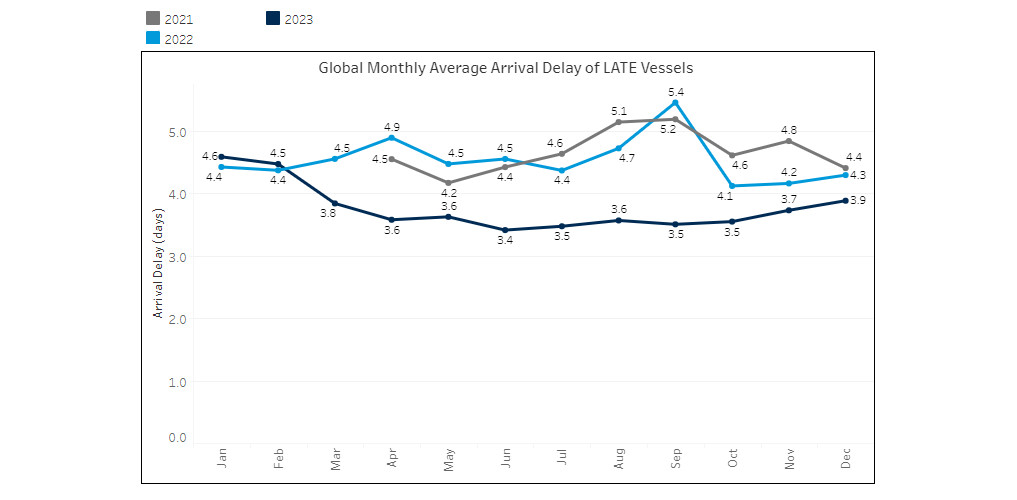
For ALL vessels, the global monthly average delay in arrival also increased by 0.2 days month-on-month to reach 1.7 days in December. This figure surpassed December 2022’s average arrival delay of 1.5 days.
Reliability per Trade Lane
The overall decline in reliability impacted some trade lanes more than others. The Transatlantic and Transpacific declined by four and six percentage points, respectively.
The schedule reliability on the Transatlantic dropped to 47.5%, ranking as the least reliable trade for December.
In contrast, Mediterranean/ Black Sea-North America improved by four percentage points to 49.1% from 44.7% in November.
However, the trade with the most significant improvement was North Europe-South America, increasing by more than 30% month-on-month. Its on-time performance jumped to 73.9% from 56.4% in November.
As illustrated in the graph below, Mediterranean/Black Sea- South America holds its position as the best-performing trade for the month with a reliability of 79.9%
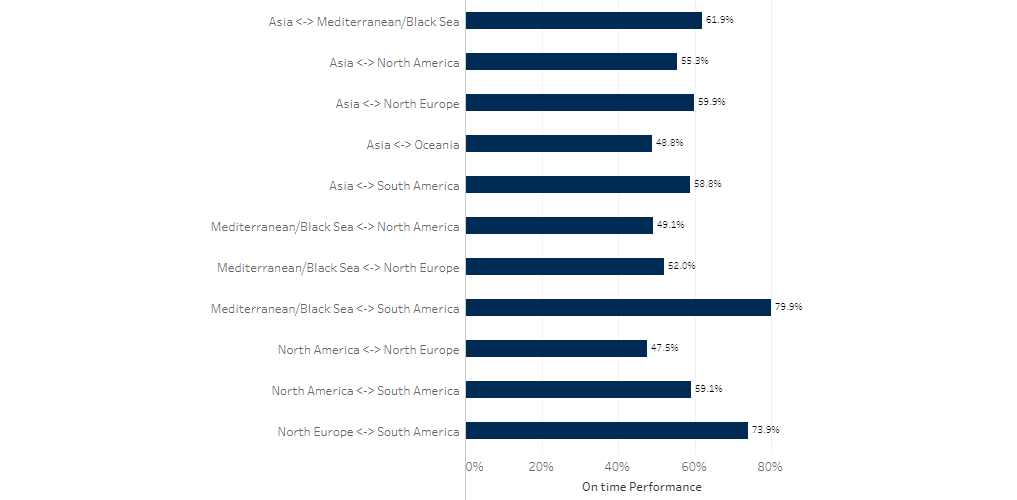
Reliability 2023
Global on-time performance fluctuated between 63.8% and 69.3% for nine months of 2023. This is a notable improvement in the performance compared with 2021 and 2022. However, the situation in the Red Sea has impacted reliability in the last month, resulting in a drop to December 2022 levels.
Carriers have diverted ships around the Cape of Good Hope, avoiding the Suez Canal. This results in vessels that were initially expected to arrive in December now arriving in January. It is worth noting that these vessels are excluded from December’s results.

For the full year, the average arrival delay for LATE vessels was below the 4-day mark, slightly above the average for the full year of 3.7 days.
The average arrival delay for ALL vessels did not exceed two days in 2023, maintaining an average for the year of 1.2 days. However, the trend is currently upwards, ending with 1.7 days in December.
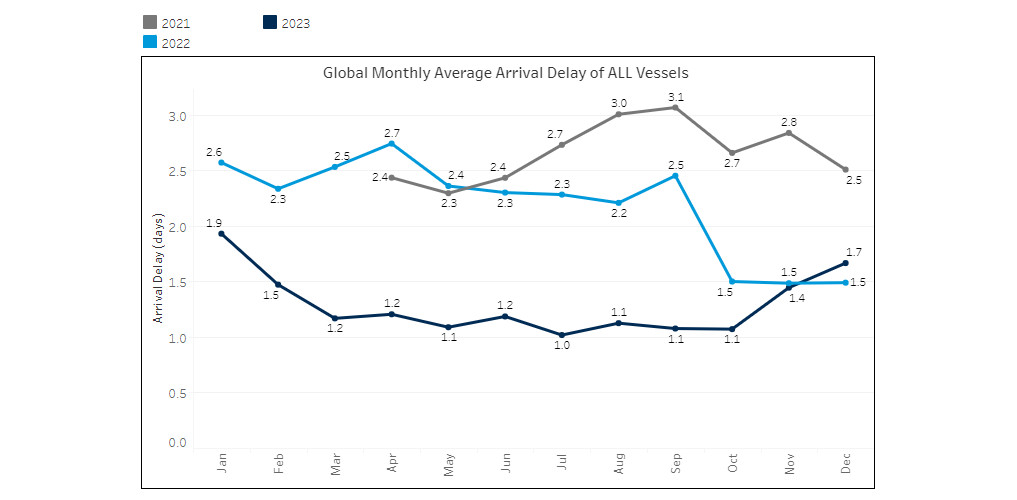
Conclusion
In short, global on-time performance declined again month-on-month by four percentage points to 56.7%.
Both the Transatlantic and Transpacific registered a weakening in reliability for December.
Reliability on Transpacific declined by four percentage points to 55.3%. Blank sailings data covering the month of December (weeks 49 to 52) shows that carries blanked nearly 16.7% of the total offered capacity on the eastbound leg of the Transpacific trade.
The six percentage point drop for the Transatlantic, to 47.5%, resulted in the trade being least reliable for December.
Most Mediterranean trades saw improvement in reliability, except for the Asia-Mediterranean/Black Sea trades, which declined by two percentage points to 61.9%.
For 2023, global on-time reliability has returned to 2022 levels. Since diverted vessels are not included in this month’s data, reliability is expected to drop again in January.
Methodology
Calculating the on-time performance
To calculate the on-time performance of a service, Kuehne+Nagel uses vessel schedules from carrier(s) offering that service. Only carrier schedules that match our quality criteria are used for the schedule reliability calculation.
As carriers update schedules constantly, they become more accurate the closer vessels get to a destination port. For this reason, we have implemented a “schedule freeze period” of 14 days prior to actual vessel arrival. In other words, we benchmark the actual arrival with what carriers last announced 14 days earlier. To identify the actual time of arrival, Kuehne+Nagel consumes AIS (Automatic Identification System) vessel data. All vessels which arrive within a +/- 24-hour window at the port of destination compared to the last announced arrival are considered to be on time.
Assigning carrier services to multiple trade lanes
Many services operate on various trade lanes (e.g. a carrier service between Asia and North Europe also calls ports in the Middle East and or the Mediterranean), and therefore carrier services may be listed in multiple trade lanes.
Definition of trade lanes
There is no common standard for the definition of trade lanes. This means, depending on the source, you will find different trade lanes as well as different regions, countries and ports assigned to a trade lane. Kuehne+Nagel has defined its own way of mapping and has assigned ports to these trade lanes accordingly. On-time performances of vessels are captured in our reports on defined main trades, meaning trades moving large container volumes on vessels. Therefore, niche trades and services within one trade, called “Intra Trade “services (e.g. Intra-Asia, Intra-Europe) are currently out of scope.
Source: Kuehne + Nagel seaexplorer Analytics
